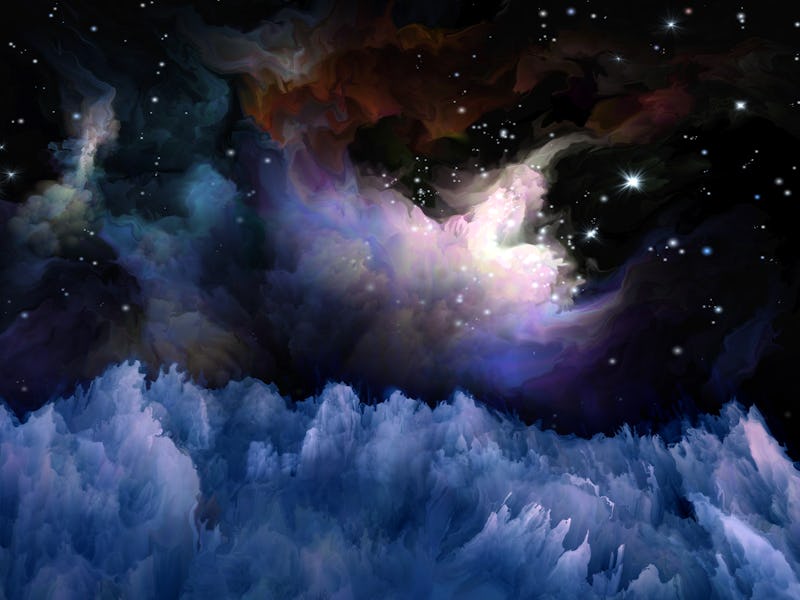Christopher Paolini reads an exclusive preview of To Sleep in a Sea of Stars
Paolini shares his love letter to sci-fi on Inverse Happy Hour.

Christopher Paolini is well known in the fantasy world for his beloved series, Inheritance Cycle, that tells the story of a young boy named Eragon who stumbles upon a dragon egg in the forest. He's also a guest on Inverse Happy Hour where he dives into his latest work, To Sleep in a Sea of Stars. It's a departure from the style of fantasy writing he's known for but will surely delight fans of Ridley Scott's Alien, Dune, the Hyperion Cantos series, Ray Bradbury, and Ursula K. Le Guin, all of which he credits as inspiration.
“I hope it's my best effort at writing a love letter to that genre,” he says.
In a Q&A, Paolini reveals why he chose to delve into sci-fi this time around; the advice he has for young writers just starting out (he was a teen himself when he started to write Eragon); the odds of an Eragon film reboot (Arya is a Disney princess now...), his self-isolation wizard beard, and when fans can expect the fifth book of the Inheritance Cycle (it's coming).
He also took the opportunity to recommend one of his “all-time top 10 pieces of media ... if you're looking for some great paranoid dystopian sci-fi,” which was followed by a special reading from an early chapter of his new book (which you can pre-order here), but not before he set the scene:
My main character is a woman by the name of Keira and she is on an alien moon that’s being surveyed for a potential calling. She’s been out on her survey, and she has fallen into a cave that shouldn’t be there, and the cave is very much artificial. It’s obvious that it was built and she’s just sort of looking around, taking in this artificial chamber that was not built by humans.
Below are the highlights from Inverse Happy Hour:
On the transition from fantasy to sci-fi — “I grew up reading as much sci-fi as fantasy as a kid. To me, science fiction is the fiction of the future. It tells us what could be, what we might accomplish as a species, and can serve as both hope and warning. I love it, and it’s something that I’ve always wanted to write.”
“And you know, It’s always shelved together in the bookstores anyway. If you read fantasy, the sci-fi is right there, and it’s a very easy transition for me. Although, I think the biggest difference is that in science fiction, if you want to get to a location faster, you can’t just tell the spaceships to go faster. It’s not like a horse; you can’t dig your spurs in.” Editors note: He does later acknowledge there are space horses in Star Wars.
On the secret to map-making in his books — “There are actually about six or seven new maps in the book.”
“The thing with maps is, you just have to decide what style you want, you know, whether you’re going for a traditional fantasy map or a sci-fi map, and then how you want to present the material. There are, fortunately, a great number of resources on the internet. There’s even a great website called the cartographersguild.com, and it’s a group of people and they make imaginary maps for fun, and a lot of them are actually professionals who do stuff for, you know, George R. R. Martin and all sorts of other big projects.”
“[Sci-fi] tells us what could be, what we might accomplish as a species, and can serve as both hope and warning.”
“Whether you do it traditionally or in the computer, just have fun and try to come up with something which matches the style of your writing or matches the style of your story so you have some continuity between the two of them.”
“When I was a kid reading, I loved books where there were illustrations in it. You’re going through and every once in a while you get that cool illustration, and I wanted to give that feeling to the readers of this book.”
On how he came up with the magical system in Eragon — “There is an old, old tradition both in classical fantasy and then moving back into myths and legends of words having power. If you know the true name of something, and you speak the name, you have power over that person or object.”
“So I was certainly not the person to come up with that idea, but when I started using that idea and really thinking about it, I wanted to, again, keep it grounded in physics as much as possible, and so the only really breaking of physics that occurs in my fantasy novels is the assumption that living creatures, whether they’re sentient, self-aware or not, living creatures have the ability to directly manipulate forms of energy with their minds, and that’s magic. And then everything else sort of follows from that.”
—
A huge thanks to Paolini for joining us!